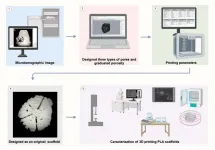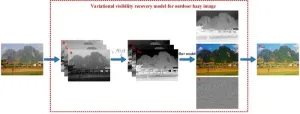How do we control the size and shape of pores in 3D scaffolds?
2024-03-06
(Press-News.org)
This article was directed and written by Dr. Lucía Pérez Sánchez, Ldi. Misael A. Ortiz de la O, Dr. Marco Antonio Álvarez Pérez and Dr. Janeth Serrano Bello (Laboratorio de Bioingeniería de Tejidos, División de Estudios de Posgrado e Investigación, Facultad de Odontología, UNAM) Dra. Monserrat Llaguno Munive (Laboratorio de Física Médica, Subdirección de Investigación Básica, Instituto Nacional de Cancerología) and Dr. Osmar A. Chanes Cuevas (Laboratorio de Investigación de Materiales Dentales y Biomateriales, División de Estudios de Posgrado e Investigación, Facultad de Odontología, UNAM). One of the significant challenges in tissue engineering is to fabricate customized scaffolds, control the microarchitecture's precision, the pores' size and shape, and regenerate defects of critical size in bone tissue. For this reason, the authors of this project decided to design a scaffold that had an exact size to the bone defect, using microtomographic images of a critical size bone defect in Wistar rat calvaria, with the scaffold-specific features such as different pore sizes (graded porosity) and three different types of pores (closed, blind and open), with the scaffold having different pore sizes (graded porosity) and three different types of pores (closed, blind and open), with the scaffold specific features such as The main objective, is to generate topological signals for the cells that favour bone regeneration, justifying this design in reported studies where they indicate that the size and shape of the pores cause a change in the cellular response and also favour vascularization in the defect area. To fabricate the scaffold, the authors decided to use the Fused Deposition Modeling (FDM) printing technique with the polymer filament of Poly Lactic Acid (PLA); this technique allows control of the pores' size and shape. However, it is necessary to standardize the printing parameters to achieve the desired shape and pore sizes; therefore, In this project, more than 50 printing parameters were standardized using Ultimaker Cura software; once this action was performed, the exact scaffold was printed to the bone defect with different pore sizes (200 microns - 700 microns), where the smallest pores were concentrated at the edge of the scaffold. The most prominent pores in the centre of the scaffold and the three types of pores were included. Once the scaffolds were printed, their surface characteristics were evaluated by scanning electron microscopy (SEM) images, their mechanical properties (Young's modulus and maximum stress), and their cellular response with the cell viability assay using dental pulp-derived mesenchymal stem cells (DPSC). It is essential to highlight that the results showed that the size and shape of the scaffold pores could be controlled by standardizing the printing parameters since the authors compared the diameter of the printed versus designed pores using a U-Mann Whitney statistical analysis; on the other hand, concerning the cell viability results, the DPSC cells remained viable on days 3 and 7, showing a favourable cellular response, which could be verified in the SEM images where the cells were observed adhering to the scaffold and forming cellular conglomerates. Therefore, the use of this type of scaffold is promising for the field of tissue engineering and regeneration of bone defects of critical size.
See the article:
Standardization of 3D printing parameters to control the size and shape of pores in Polylactic acid scaffolds
https://doi.org/10.1002/mba2.74
END
[Attachments] See images for this press release:

ELSE PRESS RELEASES FROM THIS DATE:
2024-03-06
Holography technology can restore the complete light field information of the recorded object, which has important applications in fields like biological microscopic imaging and optical micromanipulation. One important frontier of holography is the reconstruction of realistic 3D scenes. However, the development and application of holographic technology have been hindered by the huge amount of data of the 3D scenes and the laser coherence, which leads to the slow capturing speed of the real 3D scenes ...
2024-03-06
Under real-world haze conditions, the captured images not only suffer from the haze but also are affected by the noise, which significantly deteriorates the visibility of images. However, most of existing haze removal methods mainly focus on the haze degradation and fail to consider the noise interference.
To address the above issue, a research team led by Hailing XIONG and Yun LIU published their new research on 15 Feb 2024 in Frontiers of Computer Science co-published by Higher Education Press and Springer Nature.
The team proposed a novel unified variational model consisting of multiple effective constraints that simultaneously ...
2024-03-06
SAN DIEGO–—Elephants are the natural carriers of a virus called Elephant Endotheliotropic Herpesvirus (EEHV) that can, for yet unknown reasons, cause profound clinical signs in some young elephants and be rapidly fatal. For nearly two decades, zoos and university partners have been working to study the virus and develop early detection protocols and treatment options.
Veterinarians and clinical pathology researchers at San Diego Zoo Wildlife Alliance (SDZWA) and the University of Copenhagen, Denmark, have recently made an important discovery, now published in the March 2024 Journal of Zoo and Wildlife Medicine. They found that population-based reference ...
2024-03-06
Sports coaches could strengthen athletes’ mental health and protect them from mental illness – by adopting an ‘authentic leadership’ style, a new study reveals.
Researchers found when athletes perceived that their coach engaged in behaviours such as openly sharing information, showing understanding of their strengths and weaknesses, acting in an ethical manner, and listening to alternative perspectives, they felt happier and dealt with problems more easily.
Publishing their findings today (6 March) in Psychology of Sport and Exercise, experts from the University of Birmingham reveal ...
2024-03-06
Every year, more than one million deaths globally occur because of exposure to short-term (hours to days) fine particulate matter (PM2.5) in air pollution, according to a new report, with Eastern Asia reporting more than 50% of deaths attributable to short-term PM2.5 globally.
To date most studies have focused on the health impacts of living in cities where pollution levels are consistently high, ignoring the frequent “spikes” in pollution that can impact smaller urban areas that occur for instance landscape fires, dust, and other intermittent ...
2024-03-06
Living in leafy areas near gardens, parks, and green spaces, may boost bone density and lower the risk of osteoporosis, finds research published online in the Annals of the Rheumatic Diseases.
Lower levels of air pollution in green spaces is a significant contributory factor to the associations found, conclude the researchers.
Osteoporosis weakens bones, making them fragile and prone to fracture. It can lead to chronic pain, diminished mobility, and poorer quality of life. Already a major health issue worldwide, its global prevalence is set to rise with the rapid ageing of the population and changes in ...
2024-03-06
Every additional step up to around 10,000 steps per day reduces the risk of death and cardiovascular disease (CVD), regardless of how much remaining time is spent sedentary, reports a large population-based study published online in the British Journal of Sports Medicine.
Some previous studies have shown that greater daily step counts are associated with lower levels of death and CVD, while others have linked high levels of sedentary behaviour with increased risks of CVD and death. However, none of these studies investigated whether high levels of physical activity may offset or lessen the higher risk of death and CVD ...
2024-03-06
Even people whose physical activity levels fall short of recommended guidelines, but who manage to do some during their leisure time, are likely to have a lower risk of stroke than their sedentary peers, suggests a pooled data analysis of the available evidence, published online in the Journal of Neurology Neurosurgery & Psychiatry.
The effects are independent of age and sex, the findings show, prompting the authors to suggest that everyone should be encouraged to do whatever level of physical activity they can manage in their leisure time.
There’s no doubt that ...
2024-03-06
In good news for office workers, a new study from the University of Sydney’s Charles Perkins Centre (Australia) has found increasing your step count may counteract the health consequences of too much sedentary time each day.
The study of over 72,000 people, published in the British Journal of Sports Medicine, found every additional step up to around 10,000 steps a day was linked to reduced risk of death (39 percent) and cardiovascular disease (21 percent) regardless of how much remaining time was spent sedentary.
Previous studies have shown an association between greater daily step count and lower levels ...
2024-03-06
The endoscopic mapping device, developed over more than a decade by scientists at the Auckland Bioengineering Institute, consists of an inflatable sphere covered in sensors, delivered down the oesophagus and able to measure electrical activity in the gut.
In the same way abnormal heart electrical signals can cause serious heart problems, so research has found faulty bioelectric gut waves can lead to stomach pain, nausea, vomiting and bloating.
But often doctors can’t find out what the problem is. ...
LAST 30 PRESS RELEASES:
[Press-News.org] How do we control the size and shape of pores in 3D scaffolds?




